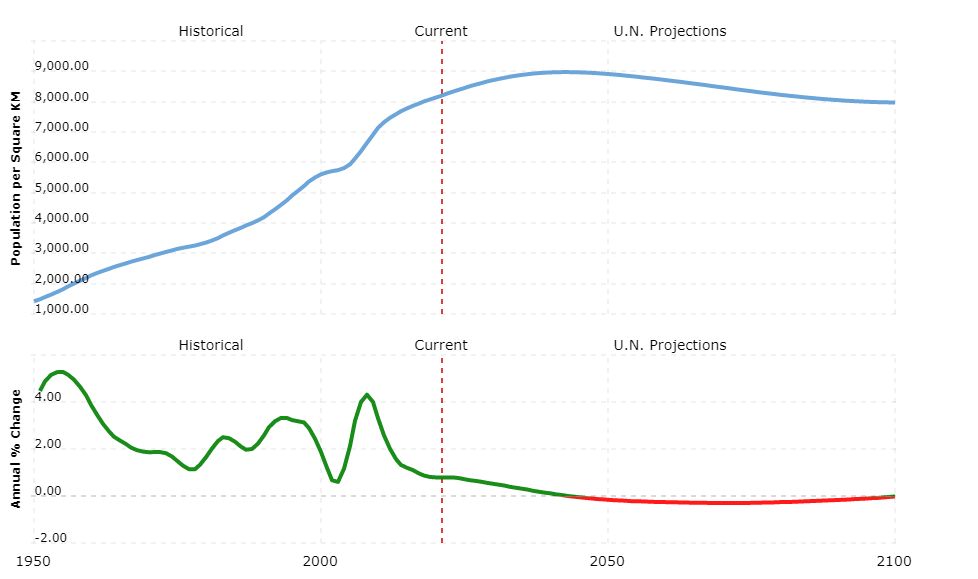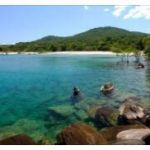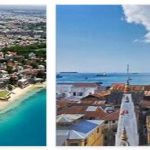| Official language | Malay, Chinese, Tamil, English |
| Capital | Singapore |
| Form of government | parliamentary republic (in the commonwealth) |
| Area | 683 km² |
| Residents | 4,420,000 |
| Currency | Singapore dollar |
| Time zone | UTC + 8 |
| License plate | SGP |
| Internet TLD | .sg |
| Telephone area code | 0065 (Source: ALLCITYCODES) |
Geography
Singapore, an independent state since 1965, is a small, very densely populated country with around 682.7 km² and over 4.42 million residents. It consists of 55 islands that lie in front of the southern tip of the Malay Peninsula (Malacca). 90% of the country’s total area is on the largest of the islands, Singapore. A 1.2 km long dam leads over the Strait of Johor and connects the island with the mainland of Malaysia. The highest point in Singapore is Timah Hill (Bukit Timah) in the center of the main island at around 177 m. The landscape is flat-waved and crossed by many smaller bodies of water. The largest rivers are the Singapore, the Seletar and the Rochor. The land area is constantly increasing due to fillings on the coasts. See Singapore country abbreviation.
Climate
Singapore has a tropical climate: year-round, the high temperatures are not subject to major fluctuations; the average temperature in the capital in January and July is around 27 °C. The frequent rainfall is distributed throughout the year (around 2,400 mm) with a slight increase in the months of November to January and ensures high humidity.
Flora and fauna
The forests that exist on Singapore today were all planted after the rainforest that once covered the island was completely cleared. Due to the population density, there is little original vegetation left, apart from the mangrove forests on the coastal regions.
Due to the sparse living space, the animal world is also very limited. In the mangrove forests there are a variety of different bird and snake species (such as the cobra). Larger wild mammals are mainly different types of monkeys such as the Plumplori, which belongs to the lemurs.
Population
In the Republic of Singapore, 6,474 people live in one square kilometer, in some parts of the city the population density is significantly higher due to the high-rise buildings. Population growth is around 1.5%. Over three quarters of the population are Chinese whose ancestors immigrated to the islands during the British colonial period. At around 15%, the Malays form the largest minority, most of whom live in the hinterland of the main island or on the smaller islands. Relatives of Indian peoples (around 7%) live mainly in the capital Singapore in a separate district (Serangoon Road).
The most widespread religion in Singapore, around 43%, is Buddhism. According to COUNTRYAAH, 15% of the population, mostly Malays, are followers of Islam. The third largest faith group with around 13% are Christians, followed by Taoists (9%) and Hindus. The official languages in Singapore reflect the composition of the population: Chinese (Mandarin and the dialects Hokkien, Cantonese and others), Malay, Tamil and English are spoken equally.
Life expectancy in Singapore is 82 years. There is no compulsory schooling for children, but there is a right to free education. The illiteracy rate is around 7%.

Political system
Singapore is a parliamentary republic (in the Commonwealth), the constitution is from 1959. The head of state is the President (since September 2011 Tony Tan Keng Yam), who is directly elected by the people for six years. He appoints the ministers, who in turn are responsible to the parliament. The head of government is the Prime Minister (Lee Hsien Loong since August 2004).
The unicameral parliament has 87 seats, the members are elected for five years. Up to nine MPs can also be appointed. Parliament has been dominated by the People’s Action Party (PAP) since independence. The mere majority voting right limits the opposition’s chances of being elected. In Singapore, every citizen aged 20 and over is required to participate in elections.
The legal system is based on British common law.
Singapore is divided into five districts.
Economy
Singapore is one of the most prosperous countries in the world and is one of the industrialized nations. The basis for this prosperity was the strategically favorable location of the city-state in the past centuries, today the port of Singapore is a big transshipment point for goods from all over the world. As a banking and financial center, the country is also among the world leaders. There are well over 100 banks in Singapore, almost 90% of which are branches of foreign companies. Corruption is practically unknown.
Agriculture in Singapore is virtually irrelevant. Only around 1% of the country’s area is used for agriculture. All food must be imported, including drinking water, which comes into the country from Malaysia via a pipeline.
Raw materials must also be imported, with the exception of granite, Singapore has no deposits. Nevertheless, industry generates more than a quarter of its gross domestic product (including electronics, oil processing, machinery and equipment, ship repair and, increasingly, biotechnology / pharmacy). Tourism also plays an important role. The main trading partners are Malaysia, China, Indonesia and the USA. The currency is the Singapore dollar.







